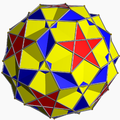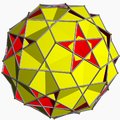Top Qs
Timeline
Chat
Perspective
Rhombicosahedron
From Wikipedia, the free encyclopedia
Remove ads
In geometry, the rhombicosahedron is a nonconvex uniform polyhedron, indexed as U56. It has 50 faces (30 squares and 20 hexagons), 120 edges and 60 vertices.[1] Its vertex figure is an antiparallelogram.
| Rhombicosahedron | |
|---|---|
 | |
| Type | Uniform star polyhedron |
| Elements | F = 50, E = 120 V = 60 (χ = −10) |
| Faces by sides | 30{4}+20{6} |
| Coxeter diagram | |
| Wythoff symbol | 2 3 (5/4 5/2) | |
| Symmetry group | Ih, [5,3], *532 |
| Index references | U56, C72, W96 |
| Dual polyhedron | Rhombicosacron |
| Vertex figure |  4.6.4/3.6/5 |
| Bowers acronym | Ri |

Remove ads
Related polyhedra
A rhombicosahedron shares its vertex arrangement with the uniform compounds of 10 or 20 triangular prisms. It additionally shares its edges with the rhombidodecadodecahedron (having the square faces in common) and the icosidodecadodecahedron (having the hexagonal faces in common).
 Convex hull |
 Rhombidodecadodecahedron |
 Icosidodecadodecahedron |
 Rhombicosahedron |
 Compound of ten triangular prisms |
 Compound of twenty triangular prisms |
Remove ads
Rhombicosacron

The rhombicosacron is a nonconvex isohedral polyhedron. It is the dual of the uniform rhombicosahedron, U56. It has 50 vertices, 120 edges, and 60 crossed-quadrilateral faces.
Remove ads
References
External links
Wikiwand - on
Seamless Wikipedia browsing. On steroids.
Remove ads


